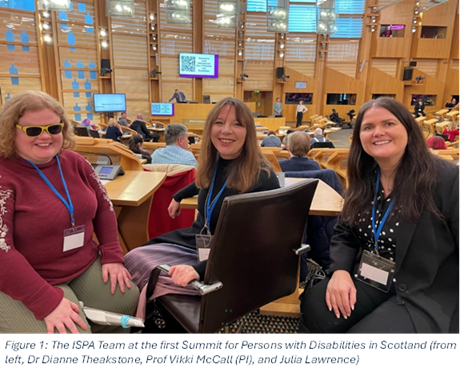Don’t Box Me In: 30 Years on from the Disability Discrimination Act (1995)
This year marks 30 years since the introduction of the Disability Discrimination Act (1995). At the time, the Act was a landmark step towards equal rights for disabled people. But three decades on, the question remains: how much has really changed?
Our team brings lived as well as professional perspectives to this question. Dr Dianne-Dominique Theakstone is a registered blind Research Fellow on the Intersection of Stigma and Place-based Ageing (ISPA) project (hosted on the Housing LIN website), and Community Peer Researcher Paula Rogers shares her own story of navigating disability, stigma, age and place. Together, we show how legislation alone is not enough without an intersectional lens.
That’s why our project works with Community Peer Researchers like Paula Rogers, whose story powerfully shows how disability, stigma, age and place intersect to shape everyday life.

Paula’s story: "Don’t box me in"
At 21, I developed a spinal cord injury and suddenly had to adapt from working and walking, to no job, learning to take steps again and use a manual wheelchair, which later progressed to a powered wheelchair full time. I quickly discovered that my historic market town wasn’t built or adapted for physical disability and use of a manual/powered wheelchair.
After leaving hospital, I returned to my childhood flat: 13 steps to the landing, five more to the front door, all on a steep hill. By the time I got to physiotherapy, I was already exhausted.
When I applied for accessible housing, the system barely recognised my existence. My application couldn’t even be processed unless my date of birth was entered as “1900.” Most accessible housing was reserved for people over 50 or 60 - so at 21, I was invisible.
I spent over a year stuck in that flat before moving to a two-level property, still with stairs and only a bath. Two years later, I finally got my current home: a bungalow with an adapted wet-room. It’s not perfect - my powered wheelchair only just fits through the doors - but it’s mine, and I love it.
The views of the castle ruins are stunning, though snowdrifts can leave me stranded when I need an ambulance. Many local shops remain inaccessible, so I shout my orders from the doorway, with half the town hearing my shopping list. Public transport is limited too: the bus has space for only one wheelchair, and I’m not the only user in town.
Sometimes it feels like living in the Hotel California - lovely to look at, but hard to leave.
Beyond legislation
Paula’s story shows why the Disability Discrimination Act, and later the Equality Act (2010), cannot be seen as the end of the road. Rights on paper don’t automatically translate into rights in practice.
Accessibility is not just about buildings or buses; it’s about dignity, independence, and community life. And when disability intersects with age, stigma, and place, these barriers are magnified.
A call to action
The DDA was never meant to be the final word. Thirty years later, we should be asking: how do we design towns, services, and systems that don’t box people in, but open doors?
That’s what our work on ISPA is all about - learning from lived experience, and co-producing change that lasts.
As Dianne’s perspective as a registered blind researcher and Paula’s as a wheelchair user make clear, disability is never just one characteristic: it interacts with place, age, and stigma in ways policy alone cannot fix.
Thirty years on from the DDA, the fight for equality is not over. It is lived every day and it must be acted on together.
The support of the Inclusive Ageing call grant number: ES/W012677/1 from the Economic and Social Research Council (ESRC) is gratefully acknowledged.
This is the third in a series of Housing LIN guest blogs leading up to the 30th anniversary of the Disability Discrimination Act. The series will end in an extended HAPPI Hour webinar on Tuesday, 11 November 2025, where contributors will share expert insights and assess progress on disability, accessible housing, and the built environment.
For more about the ISPA project and the Inclusive Living Alliance, visit the ISPA webpages hosted on the Housing LIN’s website.

Comments
Add your comment